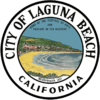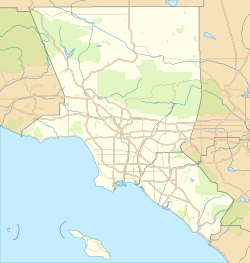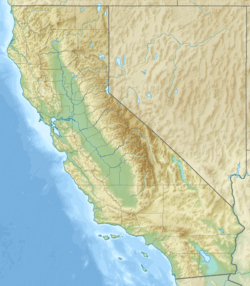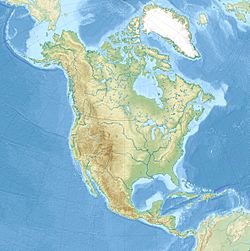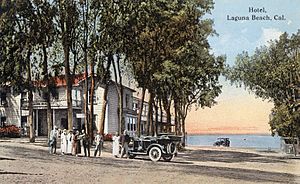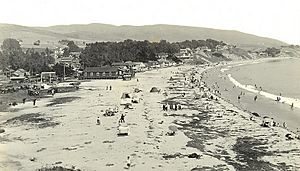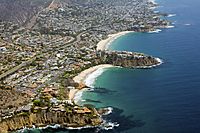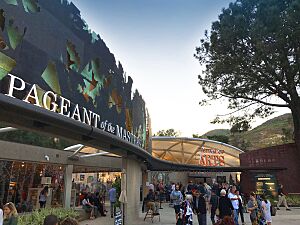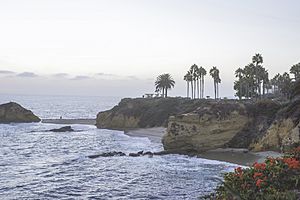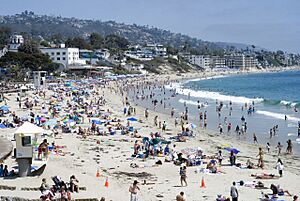Laguna Beach, California facts for kids
Quick facts for kids
Laguna Beach, California
|
|||
|---|---|---|---|
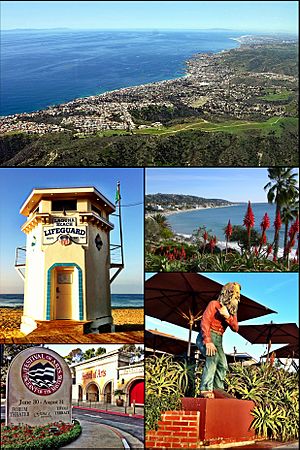
Images from top, left to right: Laguna Beach coastline, Lifeguard Tower, view from Heisler Park, Festival of Arts, and statue of Town Greeter Eiler Larsen
|
|||
|
|||
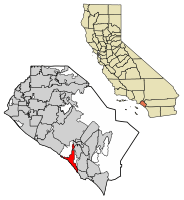
Location of Laguna Beach in Orange County, California
|
|||
| Country | United States | ||
| State | California | ||
| County | Orange | ||
| Founded (post office) |
1887 | ||
| Incorporated (city) |
June 29, 1927 | ||
| Government | |||
| • Type | Council–manager | ||
| Area | |||
| • Total | 9.86 sq mi (25.55 km2) | ||
| • Land | 8.89 sq mi (23.04 km2) | ||
| • Water | 0.97 sq mi (2.51 km2) 9.89% | ||
| Elevation | 20 ft (6 m) | ||
| Population
(2020)
|
|||
| • Total | 23,032 | ||
| • Density | 2,335.9/sq mi (901.45/km2) | ||
| Time zone | UTC−8 (Pacific) | ||
| • Summer (DST) | UTC−7 (PDT) | ||
| ZIP Codes |
92651–92652
|
||
| Area code | 949 | ||
| FIPS code | 06-39178 | ||
| GNIS feature IDs | 1660874, 2411595 | ||
Laguna Beach (/ləˈɡuːnə/) is a city in Orange County, California, United States. The name Laguna means "Lagoon" in Spanish.
This city is located in Southern California right along the Pacific Ocean. It has a mild climate all year, beautiful coves, and works hard to protect its natural environment. In 2020, about 23,032 people lived here.
Laguna Beach was first settled by ancient people and later by the Tongva tribe. It became part of the United States after the Mexican–American War. The city was settled in the 1870s and officially founded in 1887. It became an incorporated city in 1927.
The city is surrounded by hills and has limited highway access. This helps keep it separate from bigger urban areas. A large part of the Laguna Beach coastline is protected as a state marine reserve.
Tourism is the main industry in Laguna Beach. About six million people visit the city every year. Some popular events include the Pageant of the Masters, Festival of Arts, Sawdust Art Festival, and Art-A-Fair.
Contents
History of Laguna Beach
Laguna Beach was once home to very old civilizations. In 1933, a fossilized skull of an ancient person, called "Laguna Woman," was found here. Scientists believe it is about 11,700 years old. Many other ancient camp sites have been found in the area too.
The native people of the Laguna Beach area were the Tongva tribe. The Spanish missionaries first met them in the 1500s. The area of Laguna Canyon was named "Glen of the Lagoons" on a Mexican map in 1841.
After the Mexican–American War ended in 1848, California became part of the United States. Much of Laguna Beach was one of the few coastal areas not part of a Mexican land grant.
Settlers started arriving after the American Civil War. They were encouraged by laws that gave land to people who would plant trees. In Laguna Beach, many planted eucalyptus trees. In 1871, the Thurston family became the first permanent settlers in Aliso Canyon.
In 1876, brothers William and Lorenzo Nathan "Nate" Brooks bought land and started the community of Arch Beach. Nate Brooks is often called the "Father of Laguna Beach."
The community grew in the 1880s. A post office was officially opened in 1887. By the early 1900s, Laguna Beach was already a popular tourist spot. Visitors would set up tents on the beaches for their summer vacations.
The beautiful coast and hills attracted plein-air painters in the early 1900s. Artists like William Wendt and Edgar Payne moved here and started the Laguna Beach Art Association. The first art gallery opened in 1918. It later became the Laguna Art Museum.
The famous Festival of the Arts and the Pageant of the Masters began in the 1920s. They became popular shows by 1936. Laguna Beach also became a favorite place for filming movies because it was close to Hollywood. Many silent films were made here, starring actors like Mary Pickford.
Laguna Beach became known as a community for artists. Even though only about 300 people lived there in 1920, many of them were artists or writers. The town was quite isolated until 1926. That's when the Pacific Coast Highway was finished, making it easier to get there.
To protect their small-town feel, residents decided to make Laguna Beach an official city. It became a city on June 29, 1927. Since then, the population has grown steadily.
Many creative and wealthy people have chosen to live in Laguna Beach. This has helped shape the town's unique culture. In the late 1960s and early 1970s, Laguna Beach was a center for the 'alternative' hippie culture in Southern California.
Geography of Laguna Beach
Laguna Beach covers about 9.86 square miles (25.4 square kilometers). Its coastline is about 7 miles (11 kilometers) long and has 27 beaches and coves. It is next to the Pacific Ocean on one side and surrounded by parks and other cities on the other sides.
The land in Laguna Beach quickly rises from the shoreline into the hills and canyons of the San Joaquin Hills. The highest point in town is Temple Hill, which is 1,007 feet (307 meters) high. Because of its hills and parks, there are only a few main roads in and out of the city. These include the Coast Highway and State Route 133 through Laguna Canyon.
The natural beauty of the beaches, rocky cliffs, and canyons has inspired many artists. The hills are also famous for mountain biking. The Laguna Coast Wilderness Park is a large 7,000-acre (2,800 ha) park with coastal canyons and the only natural lakes in Orange County.
Climate
Laguna Beach has a mild Mediterranean climate. This means it gets lots of sunshine all year. The average high temperature is around 68°F (20°C) in January and 80°F (27°C) in August. It doesn't rain much, with an average of about 13.56 inches (34.4 cm) per year.
The ocean water temperatures are usually between 59°F (15°C) in February and 68°F (20°C) in August. In early September, the water can even reach about 72°F (22°C).
| Climate data for Laguna Beach, California | |||||||||||||
|---|---|---|---|---|---|---|---|---|---|---|---|---|---|
| Month | Jan | Feb | Mar | Apr | May | Jun | Jul | Aug | Sep | Oct | Nov | Dec | Year |
| Record high °F (°C) | 89 (32) |
92 (33) |
92 (33) |
97 (36) |
100 (38) |
102 (39) |
104 (40) |
100 (38) |
108 (42) |
104 (40) |
100 (38) |
90 (32) |
108 (42) |
| Mean daily maximum °F (°C) | 68 (20) |
68 (20) |
69 (21) |
72 (22) |
73 (23) |
75 (24) |
79 (26) |
80 (27) |
80 (27) |
77 (25) |
72 (22) |
67 (19) |
73 (23) |
| Mean daily minimum °F (°C) | 44 (7) |
45 (7) |
47 (8) |
50 (10) |
54 (12) |
58 (14) |
61 (16) |
60 (16) |
59 (15) |
54 (12) |
48 (9) |
43 (6) |
52 (11) |
| Record low °F (°C) | 21 (−6) |
27 (−3) |
28 (−2) |
31 (−1) |
33 (1) |
37 (3) |
30 (−1) |
38 (3) |
40 (4) |
33 (1) |
28 (−2) |
24 (−4) |
21 (−6) |
| Average precipitation inches (mm) | 2.75 (70) |
2.96 (75) |
2.58 (66) |
0.84 (21) |
0.25 (6.4) |
0.13 (3.3) |
0.04 (1.0) |
0.12 (3.0) |
0.35 (8.9) |
0.47 (12) |
1.23 (31) |
1.84 (47) |
13.56 (344) |
| Source: The Weather Channel | |||||||||||||
Population of Laguna Beach
| Historical population | |||
|---|---|---|---|
| Census | Pop. | %± | |
| 1930 | 1,981 | — | |
| 1940 | 4,460 | 125.1% | |
| 1950 | 6,661 | 49.3% | |
| 1960 | 9,288 | 39.4% | |
| 1970 | 14,550 | 56.7% | |
| 1980 | 17,858 | 22.7% | |
| 1990 | 23,170 | 29.7% | |
| 2000 | 23,727 | 2.4% | |
| 2010 | 22,723 | −4.2% | |
| 2020 | 23,032 | 1.4% | |
| U.S. Decennial Census | |||
In 2020, the population of Laguna Beach was 23,032 people. Most residents were White, with smaller groups of Asian, Black, and other races. About 9.36% of the population was Hispanic or Latino.
In 2010, there were 22,723 people living in Laguna Beach. The city had about 10,821 households. The average household had about 2 people. About 16% of the population was under 18 years old, and 18% were 65 or older. The median age was 50.6 years.
In 2000, the population was 23,727. The median income for a household in the city was about $90,017.
Arts and Culture
The Laguna Art Museum is an important part of Laguna Beach's art scene. It started in 1918. The museum focuses on art from California.
The Pageant of the Masters, which began in 1933, happens every summer. It's a unique show where real people pose to recreate famous artworks. There are also several other art festivals held during the summer.
The Festival of Arts Fine Art Show started in the 1930s. It features works by 140 artists from Orange County. It also has daily music performances. The Sawdust Art Festival began in 1965. It shows crafts and art by many different artists. The Art-A-Fair started in 1966 and features artists from outside the area.
The Laguna Playhouse, founded in 1920, is the "oldest continuously running theatre on the west coast." It offers professional plays and shows for young people. The Irvine Bowl is a large outdoor theater used for the Pageant of the Masters and concerts.
The Laguna Beach Plein Air Painting Invitational is held every October. Painters from North America come to paint outdoors. The Laguna Beach Arts Commission also hosts free summer concerts in the park. The Laguna Beach Chamber Music Society has a music festival in the winter. Laguna Beach also hosts the Bluewater Music Festival and Kelpfest, which raises awareness about ocean health.
Sports and Recreation
Laguna Beach has a long history with surfing. The Brooks Street Surfing Classic, which started in 1955, is one of the oldest surf competitions in the world. It only happens when the waves are perfect during the summer. Only Laguna Beach residents can join. Famous surfers like Hobie Alter have competed here.
The 'Vic' Skimboarding World Championship is held at Aliso Beach. It started in 1976 and is the longest-running skimboarding contest for pros.
The Laguna Open Volleyball Tournament began in 1955. It's the second oldest volleyball tournament in the United States. Many Olympic gold medalists have played in it.
Laguna's foothill trails are famous for mountain biking. The U.S. Open for Lawnbowling is held every year at Heisler Park. There is also a historic tower, built in 1926, at Victoria Beach.
Education in Laguna Beach
Schools
The Laguna Beach Unified School District manages public schools for the city. It includes:
- One high school: Laguna Beach High School
- One middle school: Thurston Middle School
- Two elementary schools: El Morro Elementary School and Top of the World Elementary School
There is also a private elementary school, St. Catherine of Siena Parish School. Some students living near Aliso Viejo can choose to attend schools in that district if they are closer.
Higher Education
The Laguna College of Art & Design (LCAD) is a private college in Laguna Canyon. It started in 1961. LCAD offers degrees in subjects like drawing, painting, animation, and game art. About 450 students attend LCAD. The closest public college is Saddleback College.
Media
Laguna Beach is part of the Los Angeles media market. It has its own community radio station, KXRN-LP. The city also has an online newspaper called Stu News Laguna and a weekly print newspaper called the Laguna Beach Independent.
City Services
The Laguna Beach Fire Department provides fire protection. The Laguna Beach Police Department handles law enforcement. Laguna Beach City Lifeguards keep people safe on the beaches.
Laguna Beach has used goats since the 1990s to help clear brush and reduce fire risks.
Notable People
Protecting Nature
Laguna Beach is special because it's protected by a "greenbelt" of wildlands inland and a "bluebelt" of protected ocean areas. In 1968, people started working to save the hills and canyons around Laguna Beach. Now, over 20,000 acres of wildlands are protected in parks like the Laguna Coast Wilderness Park.
The Laguna Coast Wilderness Park was created in the late 1980s and early 1990s. Artists and activists worked together to stop a large housing project in Laguna Canyon. Today, the park and canyon are protected forever as open space.
The Laguna Beach State Marine Reserve (LBSMR) was set up in 2012. Most of the coastal area is a "no-take zone," meaning you can't remove fish or other marine life. This helps the ocean animals thrive. The nearby Crystal Cove State Park also protects the coast. Because of these protected areas, the waters around Laguna Beach are full of fish.
Many old American Craftsman Bungalow homes from the early 1900s are found in Laguna Beach. The city has identified over 700 historic homes and buildings.
Laguna Beach is also a "Transition Town" in the U.S. This means it focuses on making the community more sustainable. The city has taken steps to protect the environment, like joining the U.S. Mayors Climate Initiative. It also has a facility that cleans polluted water from Aliso Creek. The city has also added bike routes and passed rules against plastic bags and plastic bottles for its government.
Sister Cities
Laguna Beach has three sister cities:
 Menton, France
Menton, France San José del Cabo, Mexico
San José del Cabo, Mexico St Ives, United Kingdom
St Ives, United Kingdom
See also
 In Spanish: Laguna Beach (California) para niños
In Spanish: Laguna Beach (California) para niños



